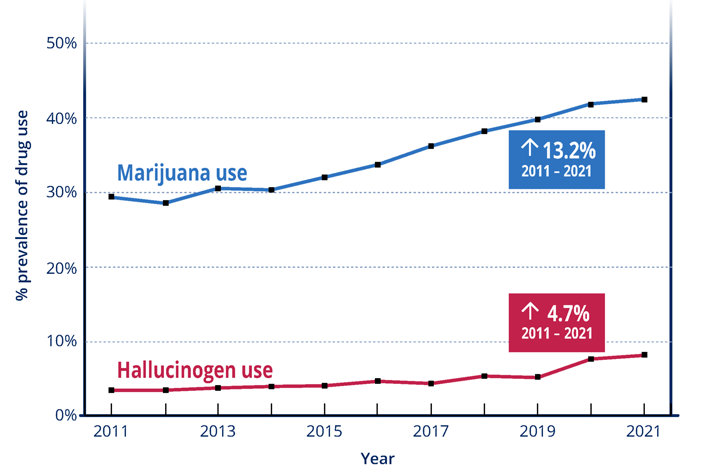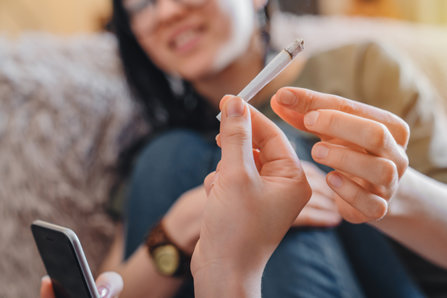Marijuana and Hallucinogen Use Reach All-Time High Among Young Adults

Behavioral trends among teenagers and people in their 20s are important because they can act as a bellwether regarding adult behavior in the future. With that in mind, a recent report by the National Institute on Drug Abuse in conjunction with the Monitoring the Future Survey has announced that the U.S. is currently experiencing the highest-ever drug abuse statistics for certain drugs of choice among young people.
Specifically, marijuana and hallucinogen usage rates among 19 to 30-year-olds are the highest ever since recording began in 1988. Further, rates of high-intensity alcohol consumption are the highest ever since recording began in 2005.
New Data on Young Adult Substance Abuse Trends
An August 22nd, 2022 paper published by the National Institute on Drug Abuse highlighted a concerning development in young adult drug abuse. According to the data, marijuana and hallucinogen use in the past year among young adults 19 to 30 significantly increased compared to five and ten years ago. Usage rates went up so high they are now the highest since 1988. Marijuana use increased 13.2% between 2011 and 2021, and hallucinogen use increased 4.7% between 2011 and 2021.

Vaping trends also spiked, especially marijuana vaping. Even after vaping trends leveled off in 2020, all forms of vaping resurged and began to climb again in 2021. Further, alcohol abuse is also on the rise, alcohol being the most used substance among young adults. While overall alcohol consumption per capita is declining among young people, binge drinking for those who drink is rising. Further, high-intensity alcohol consumption (10 or more drinks in a row) is the highest since recording began in 2005.
The importance of understanding youth substance abuse trends could not be clearer, as laid out by NIDA founder Dr. Nora Volkow: “As the drug landscape shifts over time, this data provides a window into the substances and patterns of use favored by young adults. We need to know more about how young adults are using drugs like marijuana and hallucinogens, and the health effects that result from consuming different potencies and forms of these substances. Young adults are in a critical life stage and honing their ability to make informed choices. Understanding how substance use can impact the formative choices in young adulthood is critical to help position the new generations for success.”
Marijuana Use

NIDA’s findings on marijuana usage trends were quite concerning. According to the data, past-year, past-month, and daily marijuana use in 2021 reached the highest levels since recording began in 1988. The proportion of adults ages 19 to 30 who reported using marijuana at least once in 2021 reached 43%. That’s a significant increase from 34% in 2016 and 29% in 2011. Past-month marijuana use reached 29% in 2021, compared to 21% in 2016 and 17% in 2011. Daily marijuana use was reported at 11%, compared to 8% in 2016 and 6% in 2011.
Hallucinogen Use
Unlike marijuana, which has steadily grown in popularity over the years, hallucinogen use remained mostly stable for most of the late-20th century and early-21st century. In 2020 however, usage began to increase dramatically. And in 2021, 8% of young adults reported using hallucinogens at least once, the highest ever since recording began in 1988. In 2016, only 5% of young adults used hallucinogens, and in 2011, only 3% used them. The most common hallucinogens cited for use were LSD, MDMA, mescaline, peyote, psilocybin, and PCP.
Vaping
When it first became a trend, vaping activity was not significantly monitored by the National Institute on Drug Abuse, as vaping began as a way to consume nicotine without smoking cigarettes. In more recent years, however, vaping has become a way by which some people use cannabis and other drugs, hence the interest of NIDA in reporting on vaping trends. With that in mind, while cannabis vaping trends leveled off in 2020, NIDA research indicated the use of vaporizer devices to consume cannabis products more than doubled, with 12% of young adults between the ages of 19 and 30 reporting they use vaporizers to consume cannabis monthly.
Alcohol Use
Though binge drinking among young adults dipped in 2020, this trend returned to pre-pandemic levels in 2021. Currently, 32% of young people reported binge drinking (consuming five or more drinks in a row) at some point in the past two weeks. High-intensity drinking, defined as having ten or more drinks in a row, is at the highest level it’s ever reached since recording began in 2005. 13% of young adults in 2021 said they’d engaged in high-intensity drinking at least once in the past two weeks.
Helping the Future Leaders of America Get Treatment for Drug Abuse

The Monitoring the Future Survey (the branch of NIDA that analyzes drug use trends among young people) provides a clear line of sight into the ever-changing world of drug abuse in America. It also enables policymakers and addiction professionals to predict future drug trends accurately, hence why this data is crucial in determining how to address drug abuse. To that point, Dr. Megan Patrick, a research professor at the University of Michigan and principal investigator of the Monitoring the Future Survey panel study, had this to say. “One of the best ways we can learn more about drug use and its impact on people is to observe which drugs are appearing, in which populations, for how long, and under which contexts. Monitoring the Future and similar large-scale surveys on a consistent sample population allow us to assess the effects of ‘natural experiments’ like the pandemic. We can examine how and why drugs are used and highlight critical areas to guide where the research should go next and to inform public health interventions.” Building on what Dr. Patrick said, information like the data points in this article can be useful in formatting treatment programs to help young people addicted to drugs.
“One of the best ways we can learn more about drug use and its impact on people is to observe which drugs are appearing, in which populations, for how long, and under which contexts...”
If drug use trends in today’s younger generation are not addressed, this will only lead to painful outcomes in the future. Drug abuse always worsens when allowed to continue; it seldom goes away or “gets better” without professional intervention and help. If some drug abuse trends are the highest they’ve ever been since recording began, not only is that concerning for the current adult generation, but it’s also quite concerning for the future children of those adults. We don’t want an American society run by adults who abuse drugs, and we certainly don’t want the next generation of Americans to grow up in homes where drug abuse occurs. That’s why it’s so important for young people to get help when they abuse drugs and cannot stop on their own.
Sources:
- NIDA. “Marijuana and hallucinogen use among young adults reached all time-high in 2021.” National Institute on Drug Abuse, 2022. nida.nih.gov
- NIDA. “College and Noncollege Young Adult Substance Abuse.” Monitoring the Future Survey, 2022. monitoringthefuture.org
- NIDA. “Monitoring the Future.” National Institute on Drug Abuse, 2022. nida.nih.gov


 ®
®